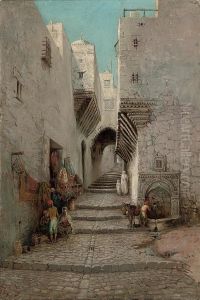William Keeling Paintings
William Keeling was an English sea captain and explorer rather than a traditional artist in the sense of painting or sculpture. Born in 1578, Keeling's contributions to history were not through canvas or clay, but through his voyages and the journals he kept during them, which have been of significant historical value. His life was marked by exploration during the Age of Discovery, a period characterized by extensive overseas exploration that led to the global mapping and interaction between distant cultures and continents. Keeling is best remembered for his role in the East India Company, an English company formed for the exploitation of trade with East and Southeast Asia and India, incorporated by royal charter on December 31, 1600.
Keeling's most notable contributions came from his voyages to India and the Spice Islands (the Maluku Islands in Indonesia), undertaken on behalf of the East India Company. He captained three voyages to the East Indies. His first voyage, which took place from 1603 to 1604, was notable for the establishment of trade relations with Aceh, a sultanate in Sumatra, and for being one of the earliest English voyages to reach the Malay Archipelago. His subsequent voyages further cemented his reputation as a skilled navigator and captain.
One of Keeling's lasting legacies was his implementation of practices to improve the health and welfare of his crew, including the introduction of a disciplined regime against scurvy, a common and often fatal disease among sailors due to vitamin C deficiency. He is also credited with being the first to formally document the practice of dancing on board ship as a morale booster and physical exercise to combat the effects of long voyages.
Despite his significant contributions to navigation and exploration, William Keeling's name is not as widely recognized as some of his contemporaries, such as Sir Francis Drake or Sir Walter Raleigh. However, his meticulous journals have provided historians with valuable insights into the early operations of the East India Company, the conditions of sea voyages at the time, and interactions with diverse cultures during the early 17th century.
William Keeling died in 1620, but his legacy lives on through his contributions to maritime history and the detailed accounts of his voyages, which continue to be a valuable resource for historians studying the era of European exploration and expansion.

